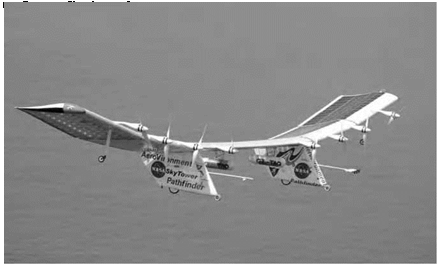Pathfinder Plus-Second-Generation ERAST Program Test Vehicle (1997-1998)
NASA and AeroVironment upgraded the Pathfinder UAV to an improved configuration known as the Pathfinder Plus, which had a longer wingspan, two additional electric motors for a total of eight motors, and improved solar cells. The two additional motors were more efficient than the six carried forward from Pathfinder. The Pathfinder Plus UAV, which was intended to serve as a "transitional” aircraft between Pathfinder and the next-generation Centurion UAV, had a wingspan of 121 feet that
 |
|
included use of four of the five wing sections from the original Pathfinder. The new center wing section contained more efficient solar cells that converted approximately 19 percent of the solar energy into electrical power for the vehicle’s motors, avionics, and communications system. This compared with an efficiency rating of only 14 percent for the solar cells on the remaining four wing sections from the original Pathfinder. The addition of the fifth wing section enabled Pathfinder Plus to generate 12,500 watts, as compared with the original Pathfinder’s 7,500 watts. Pathfinder Plus had a gross weight of 700 pounds, up to a 150- pound payload capacity, an aspect ratio of 15 to 1, a wing chord of 8 feet, and a power-off glide ratio of 21 to 1. Pathfinder Plus enabled higher – altitude flights and was used to qualify the next-generation Centurion wing panel structural design, airfoil, and SunPower Corporation’s solar array. Several flight tests were conducted in Hawaii. On its last flight, on August 6, 1998, Pathfinder Plus set a world altitude record of 80,201 feet for solar-power – and propeller-driven aircraft. These flight tests demonstrated the power, aerodynamic, and systems technologies needed for the Centurion and confirmed the practical utility of using high-altitude remotely controlled solar powered aircraft for commercial purposes.[1542]










